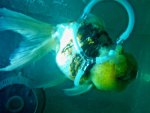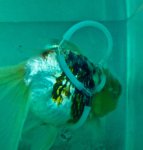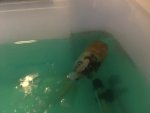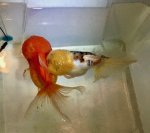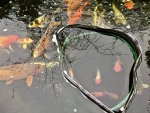I had one of my 2 y.o Orandas lost ability to normally swim due to temperature change in the pond. I took him inside, but after slowly warming up, it was no change: he was floating belly up. Tried to feed him frozen peas but he was not eating and just spitting it out. His fins and belly got burned from being exposed to air for days. After some web research I found some videos of people pull out air out swimming bladder with syringe, so I tried it but unsuccessfully. It looked like i pulled a lot of air, but either the needle on the syringe was not long enough to reach a swim bladder or for some other reason it just didn't work. Then I made him special fish harness using 4 Y type airline connections, airline tubing and a stainless steel nut for buoyancy. Just had to experiment with different sizes of nut to find the one that would work best. Lucky fish fully recovered, all burns healed and it swims normal now after 3 weeks wearing buoyancy harness.
Just made a little video story about it to possibly help other people with the same problem in fancy gold fish. I wish i'd come to this info a few years ago as i had couple other orandas that died a few years back from similar buoyancy loss and it was painful to watch them suffer for long time. I wish i'd known about this type of harness then. This time i did very extensive web search as i wasn't going to let this one go easily. I'm glad i came across this info and maybe it would help others too. Here's the you tube link to the video, as it's too large to just post it on this site. Also a few photos before while wearing a harness and after it recovered.
Just made a little video story about it to possibly help other people with the same problem in fancy gold fish. I wish i'd come to this info a few years ago as i had couple other orandas that died a few years back from similar buoyancy loss and it was painful to watch them suffer for long time. I wish i'd known about this type of harness then. This time i did very extensive web search as i wasn't going to let this one go easily. I'm glad i came across this info and maybe it would help others too. Here's the you tube link to the video, as it's too large to just post it on this site. Also a few photos before while wearing a harness and after it recovered.
Attachments
Last edited:



